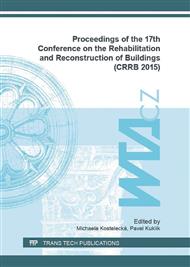[1]
M. Riedl et al., Zpráva o stavu lesa a lesního hospodářství České republiky za rok 2013, Praha, Ministerstvo zemědělství, (2014).
Google Scholar
[2]
O. Ševců, J. Vinař, M. Pacáková, Metodika ochrany dřeva, Praha, Nakladatelství Jalna, (2000).
Google Scholar
[3]
D. Bousquet, Lumber Drying: An Overview of Current Processes, Vermont, University of Vermont Extension, (2000).
Google Scholar
[4]
B. A. Jayne, Mechanical properties of wood fibers, Tappi 42 (1959) 41-46.
Google Scholar
[5]
R. Wimmer, B. N. Lucas, T. Y. Tsui, W. C. Oliver, Longitudinal hardness and Young's of spruce tracheid secondary walls nanoindentation technique, Wood Science and Technology 31 (1997) 131-141.
DOI: 10.1007/bf00705928
Google Scholar
[6]
R. Wimmer , B. N. Lucas, Comparing mechanical properties of secondary wall and cell corner middle lamella in spruce wood, IAWA 18 (1997) 77-88.
DOI: 10.1163/22941932-90001463
Google Scholar
[7]
Z. Prošek et al., Microstructure Description and Micromechanical Properties of Spruce Wood, Acta Polytechnica 55 (2015) 39–49.
DOI: 10.14311/ap.2015.55.0039
Google Scholar
[8]
Z. Prošek et al., Micromechanical Properties of Spruce Tissues Using Static Nanoindentation and Modulus Mapping, Applied Mechanics and Materials 732 (2015) 115–118.
DOI: 10.4028/www.scientific.net/amm.732.115
Google Scholar
[9]
S. A. Asif, K. J. Wahl, R. J. Colton, O. L. Warren, Nanoindentation and contact stiffness measurement using force modulation with a capacitive load-displacement transducer. Review of Scientific Instruments 70 (1999) 2408-2413.
DOI: 10.1063/1.1149769
Google Scholar
[10]
S. A. Syed Asif et al., Quantitative imaging of nanoscale mechanical properties using hybrid nanoindentation and force modulation, Journal of Applied Physics 90 (2001) 1994-1200.
DOI: 10.1063/1.1380218
Google Scholar
[11]
P. Klapálek, L. Melzerová, Methods of non-destructive assessment of timber, Applied Mechanics and Materials 732 (2015) 369–372.
DOI: 10.4028/www.scientific.net/amm.732.369
Google Scholar


